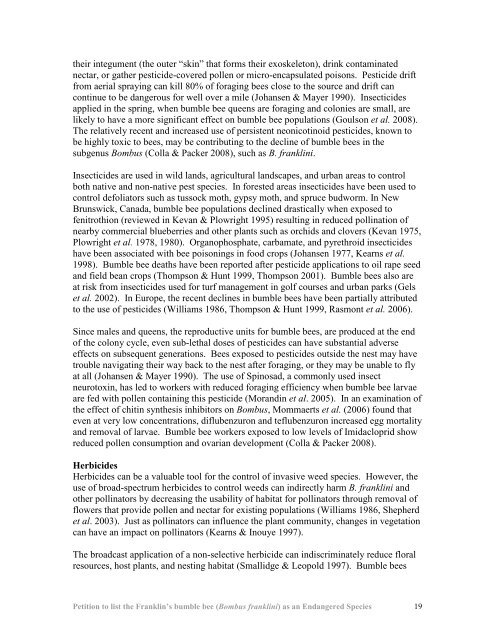Franklin's bumble bee - The Xerces Society
Franklin's bumble bee - The Xerces Society
Franklin's bumble bee - The Xerces Society
Create successful ePaper yourself
Turn your PDF publications into a flip-book with our unique Google optimized e-Paper software.
their integument (the outer “skin” that forms their exoskeleton), drink contaminated<br />
nectar, or gather pesticide-covered pollen or micro-encapsulated poisons. Pesticide drift<br />
from aerial spraying can kill 80% of foraging <strong>bee</strong>s close to the source and drift can<br />
continue to be dangerous for well over a mile (Johansen & Mayer 1990). Insecticides<br />
applied in the spring, when <strong>bumble</strong> <strong>bee</strong> queens are foraging and colonies are small, are<br />
likely to have a more significant effect on <strong>bumble</strong> <strong>bee</strong> populations (Goulson et al. 2008).<br />
<strong>The</strong> relatively recent and increased use of persistent neonicotinoid pesticides, known to<br />
be highly toxic to <strong>bee</strong>s, may be contributing to the decline of <strong>bumble</strong> <strong>bee</strong>s in the<br />
subgenus Bombus (Colla & Packer 2008), such as B. franklini.<br />
Insecticides are used in wild lands, agricultural landscapes, and urban areas to control<br />
both native and non-native pest species. In forested areas insecticides have <strong>bee</strong>n used to<br />
control defoliators such as tussock moth, gypsy moth, and spruce budworm. In New<br />
Brunswick, Canada, <strong>bumble</strong> <strong>bee</strong> populations declined drastically when exposed to<br />
fenitrothion (reviewed in Kevan & Plowright 1995) resulting in reduced pollination of<br />
nearby commercial blueberries and other plants such as orchids and clovers (Kevan 1975,<br />
Plowright et al. 1978, 1980). Organophosphate, carbamate, and pyrethroid insecticides<br />
have <strong>bee</strong>n associated with <strong>bee</strong> poisonings in food crops (Johansen 1977, Kearns et al.<br />
1998). Bumble <strong>bee</strong> deaths have <strong>bee</strong>n reported after pesticide applications to oil rape seed<br />
and field bean crops (Thompson & Hunt 1999, Thompson 2001). Bumble <strong>bee</strong>s also are<br />
at risk from insecticides used for turf management in golf courses and urban parks (Gels<br />
et al. 2002). In Europe, the recent declines in <strong>bumble</strong> <strong>bee</strong>s have <strong>bee</strong>n partially attributed<br />
to the use of pesticides (Williams 1986, Thompson & Hunt 1999, Rasmont et al. 2006).<br />
Since males and queens, the reproductive units for <strong>bumble</strong> <strong>bee</strong>s, are produced at the end<br />
of the colony cycle, even sub-lethal doses of pesticides can have substantial adverse<br />
effects on subsequent generations. Bees exposed to pesticides outside the nest may have<br />
trouble navigating their way back to the nest after foraging, or they may be unable to fly<br />
at all (Johansen & Mayer 1990). <strong>The</strong> use of Spinosad, a commonly used insect<br />
neurotoxin, has led to workers with reduced foraging efficiency when <strong>bumble</strong> <strong>bee</strong> larvae<br />
are fed with pollen containing this pesticide (Morandin et al. 2005). In an examination of<br />
the effect of chitin synthesis inhibitors on Bombus, Mommaerts et al. (2006) found that<br />
even at very low concentrations, diflubenzuron and teflubenzuron increased egg mortality<br />
and removal of larvae. Bumble <strong>bee</strong> workers exposed to low levels of Imidacloprid show<br />
reduced pollen consumption and ovarian development (Colla & Packer 2008).<br />
Herbicides<br />
Herbicides can be a valuable tool for the control of invasive weed species. However, the<br />
use of broad-spectrum herbicides to control weeds can indirectly harm B. franklini and<br />
other pollinators by decreasing the usability of habitat for pollinators through removal of<br />
flowers that provide pollen and nectar for existing populations (Williams 1986, Shepherd<br />
et al. 2003). Just as pollinators can influence the plant community, changes in vegetation<br />
can have an impact on pollinators (Kearns & Inouye 1997).<br />
<strong>The</strong> broadcast application of a non-selective herbicide can indiscriminately reduce floral<br />
resources, host plants, and nesting habitat (Smallidge & Leopold 1997). Bumble <strong>bee</strong>s<br />
Petition to list the Franklin’s <strong>bumble</strong> <strong>bee</strong> (Bombus franklini) as an Endangered Species 19
















